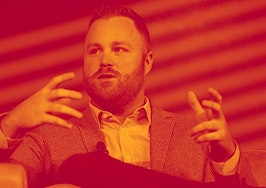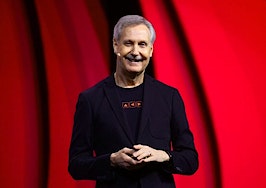During a company conference Saturday afternoon, Keller Williams President Josh Team argued that popular real estate portals succeed because they built “the thing that all the consumers want” — and that his company ultimately decided to do the same thing with its new app.
Team was speaking during Keller Williams’ annual Family Reunion conference in Dallas, Texas, during which the firm reports on its recent earnings performance and major initiatives. This year, Team focused most of his time on stage discussing Keller Williams new consumer-facing app, which Inman previewed earlier this month.
During the presentation, Team showed an image of a typical real estate website side-by-side with a portal. The real estate website had a variety of sections filled with things like featured listings. Meanwhile, the portal “just built a big search box” with not much else on the homepage.
The portals — websites like Zillow and Trulia — took this approach because they found that “every time they put something else on that screen, the consumer closed the window,” Team said.
When Team then compared the visual presentation of search results, the standard real estate website looked like a database, or what someone might see while using a multiple listing service (MLS).
The portal, on the other hand, “looked like a photo gallery.”

A slide, shared by Team during Saturday’s event, shows a traditional real estate website side-by-side with a portal. Credit: Keller Williams
These two, disparate consumer experiences explain why the portals have been so successful.
“This is why the portals have all the consumer eyeballs,” Team said to the gathering of Keller Williams agents. “Because they built the thing that all the consumers want.”
Company co-founder and co-owner Gary Keller — who appeared on stage with Team — said that conventional real estate websites tended to focus on different things other than simple searches because “agents believed that self-promotion was the most important thing.” Portals, by contrast, “give the consumer exactly what they want,” Keller said.
And according to Team, consumers simply want to get to the home listings quickly and easily. And they want a visual experience with a lot of photos.
So that’s what Keller Williams’ new app seeks to deliver. In other words, the app is more portal-like, copying the best things from popular consumer sites and, according to the company, improving on them via integrations with other Keller Williams technology.

Credit: Keller Williams
The app is slated to launch publicly by Feb. 19.
Team said Saturday that so far in tests the results have been “materially better” than older, more conventional websites. He also said that engagement has risen by 10 times.
Keller and Team also both said that the integration of the app with their company’s other software is significant. Specifically, the app seeks to solve what Team described as both an agent and consumer journey that “is disconnected and fragmented.”
“The agent world isn’t connected, the consumer world isn’t connected,” Team said, “and when you add those two together it’s just chaos.”
The new app organizes the chaos by plugging directly into Keller Williams’ platform, called Command, for agents.
“The operating system for Command is the same software for the consumer app,” Keller explained. “These are actually just two different screens, if you will, all operating on the same platform.”
To drive that point home, Team showed a video in which tasks were performed on the app. As things like searches took place, they showed up in Command, which was visible on a parallel screen. The point was that when both agents and their clients use Command and the app, the agents will get real-time insights into what their clients are doing.
“Everything that’s happening in their app,” Team said, “you have full visibility, so you can create a better experience.”
Team on Saturday also highlighted a number of other victories he said Keller Williams has recently accomplished using its technology, including generating leads for $1.94 a pop — far less than the $12 to $15 per lead agents end up paying via their customer relationship managers (CRM), or the $50 they pay using a portal.
He also said new features in Command will boost productivity, with things such as collaboration capabilities being “basically Slack meets Trello” — a reference to two popular apps for communication and task management, respectively.
The overall goal, he ultimately concluded, was to improve the experience of both real estate professionals and consumers by building “an ecosystem that organized all this chaos.”
“The whole promise of this journey,” Team said, “was the end-to-end platform.”













